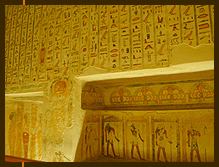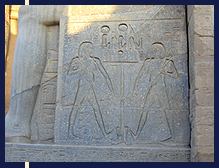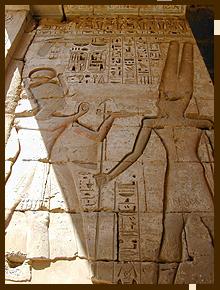|
The
Ancient Egyptian civilisation was one of the first, if not
indeed the first, to go beyond the mere pictorial representation
of events and to develop some kind of writing. The oldest
known samples of Ancient Egyptian writing were discovered
in Abydos and are dated to 3.100 BC or before. They are the
oldest samples of writing known to mankind up to now.
 Coloured
hieroglyphs from a royal tomb at the Valley of the Kings.
Coloured
hieroglyphs from a royal tomb at the Valley of the Kings.
|
Throughout
their more than 3.000 year long history, the Ancient Egyptians
developed and used three kinds of writing: hieroglyphic, hieratic
and demotic.
HIEROGLYPHIC
The
writing most commonly associated with the Ancient Egyptians
is called hieroglyphic, a name that comes from the Greek words
hieros (sacred) and glypho (inscription). It consists of a
large variety of images representing sounds as well as ideas
and actions. The images were normally clearly drawn, although
the amount of detail would depend on such matters as the size
of the signs, the available time to actually write the texts,
and personal taste. Thus the quality of writing can vary from
exquisitely carved signs to clumsily drawn ink marks.
 The
entire scene symbolises the unity of Upper- and Lower-Egypt.
The
entire scene symbolises the unity of Upper- and Lower-Egypt.
|
Its
versatile nature allowed it to be written in rows or in columns,
oriented from right to left or from left to right. All signs
are normally positioned as if looking towards the beginning
of the text. Just how versatile this orientation was, is shown
in the many temple reliefs that show a king facing one or
more gods. The texts share the orientation of the representations
they accompany and like the king faces the gods, so do their
respective texts.
Hieroglyphic
writing was used from the end of Prehistory, until 396 AD,
when the last hieroglyphic text was written on the walls of
the temple of Isis on the island Philae. It was used in many
different situations; for monumental inscriptions on walls
of temples and tombs, on furniture, statues, papyrus, jewellery,
sarcophagi and coffins, amongst others. It could either be
carved into a hard surface, or written in ink. In time, its
use would become more and more restricted to religious texts
on temples or in tombs, or to official royal decrees.
HIERATIC
The
earliest known examples of hieratic are only slightly more
recent than hieroglyphic. It is a more cursive form of hieroglyphic,
the result of quickly drawing signs by hand on a sheet of
papyrus with a reed brush. Here the original hieroglyphic
signs were reduced to their simplest form. Some common signs
could even be reduced to a simple stroke, smaller signs would
become mere dots or would be combined into one new sign.
|

|
Being
handwriting, hieratic would change and evolve over time. The
hieroglyphic basis of hieratic would, however, always remain
present. Most hieratic texts are therefore transcribed into
hieroglyphic by modern-day researchers.
Hieratic
was originally mainly used in administrative texts, but because
it was more practical and less time-consuming than hieroglyphics,
it found its way into literature, wisdom texts and even religious
writings. From the 25th/26th Dynasty on, its use would become
more and more restricted to religious texts. It was normally
written using a reed brush on sheets of papyrus, but hieratic
writing is also seen on tissues, pieces of cloth, and occasionally
on other substrates. Like hieroglyphic writing, it could originally
be written in rows or columns. In time, however, the writing
orientation would become standardised and hieratic would only
be written in rows from right to left.
DEMOTIC
Demotic
evolved from an even more cursive form of hieratic and became
the standard for the administration from the 25th or 26th
Dynasty on. Contrary to hieratic, demotic texts are normally
not transcribed into hieroglyphics prior to translation because
it is often impossible to relate a demotic sign to a hieroglyphic
counterpart. Sometimes one hieroglyphic sign would be written
as a group of demotic signs; or a group of hieroglyphic signs
would merge into one single demotic sign.
 Deeply
carved hieroglyphs in the temple of Ramesses III at
Medinet Habu. The text is part of the ritual scene where
the king, burns some incense for Amun-Ra.
Deeply
carved hieroglyphs in the temple of Ramesses III at
Medinet Habu. The text is part of the ritual scene where
the king, burns some incense for Amun-Ra.
|
The
variety of possible readings for one single demotic sign is
far greater than with any hieroglyphic sign. As a further
evolution of hieratic, demotic was only written in rows from
right to left. Older demotic texts were written with a reed
brush, but from the Ptolemaic era on, the reed pen would be
favoured. Demotic was mostly used for administrative and private
texts, but also for some stories and quite exceptionally in
inscriptions. The last known demotic text is an inscription
in the temple of Philae, dated to the 5th century AD.
THE
RELATIONSHIP BETWEEN HIEROGLIPHIC, HIERATIC & DEMOTIC
It
is important to note that no single type of writing would
entirely replace another, but it would merely restrict the
other writings to specific domains and be restricted itself
to other domains. Thus demotic would become the writing of
the administration from the 26th Dynasty on, but it did not
entirely replace hieratic as a handwriting, which was still
being used in religious texts.
Hieratic,
on its part, did not replace hieroglyphic either. From its
beginnings it was hieroglyphic, but more cursive, and written
by a speedier hand than hieroglyphic. As the two writings
evolved, practicality caused hieratic to be used when a text
need not be written in the slow but detailed hieroglyphic
signs. Therefore hieratic was used in such contexts as administrative
texts; texts that were not to be inscribed on monuments or
funerary objects and texts that mattered for their contents
only.
(Jacques
Kinnaer)

|
|